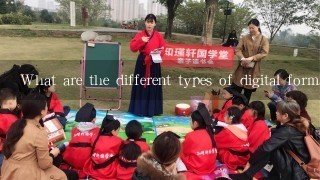What are the different types of digital formats?

Sure, here's a breakdown of the different types of digital formats:
1. Text formats:
- Plain text: This is the simplest format, consisting of characters arranged in a specific order.
- Structured text: This format uses tags and markers to define the content and structure of the text.
- Rich text: This format combines the elements of plain text with multimedia content, such as images and videos.
2. Audio formats:
- Audio files: These formats store sound recordings in various formats, including MP3, WAV, and FLAC.
- Audiobooks: Audiobooks are digital versions of books that are read aloud.
- Sound effects: These are short, discrete sounds used in movies, games, and other media.
3. Video formats:
- Video files: These formats store moving images and sound in a digital format.
- MP4: The most common video format, MP4 is used for movies, videos, and other multimedia content.
- AVI: Another widely used video format, AVI is used for a wide range of applications.
- WebM: This is a newer video format that is designed to be more efficient than MP4.
4. Image formats:
- Image files: These formats store images in a digital format.
- JPEG: A commonly used image format that is used for photographs and graphics.
- PNG: A lossless image format that is used for photographs and graphics.
- GIF: A lossy image format that is used for animations and web graphics.
5. Other formats:
- Data formats: These formats store data in a digital format, such as spreadsheets, databases, and configuration files.
- Software formats: These formats store software applications in a digital format.
- Virtual reality (VR) formats: These formats are used to create virtual reality experiences.
- Augmented reality (AR) formats: These formats are used to create augmented reality experiences.
These are just some of the many different types of digital formats. The type of format that is best for a particular application will depend on the specific requirements of that application.
































































